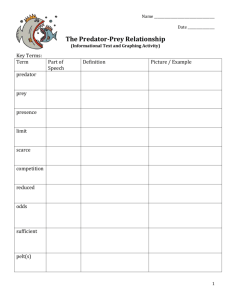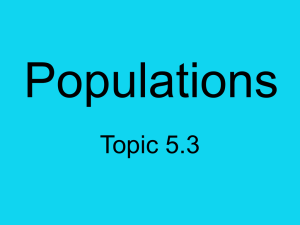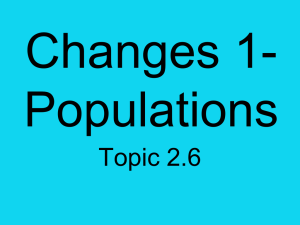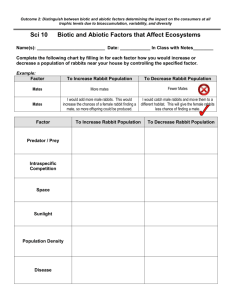Student Packet Organism Relationships
advertisement
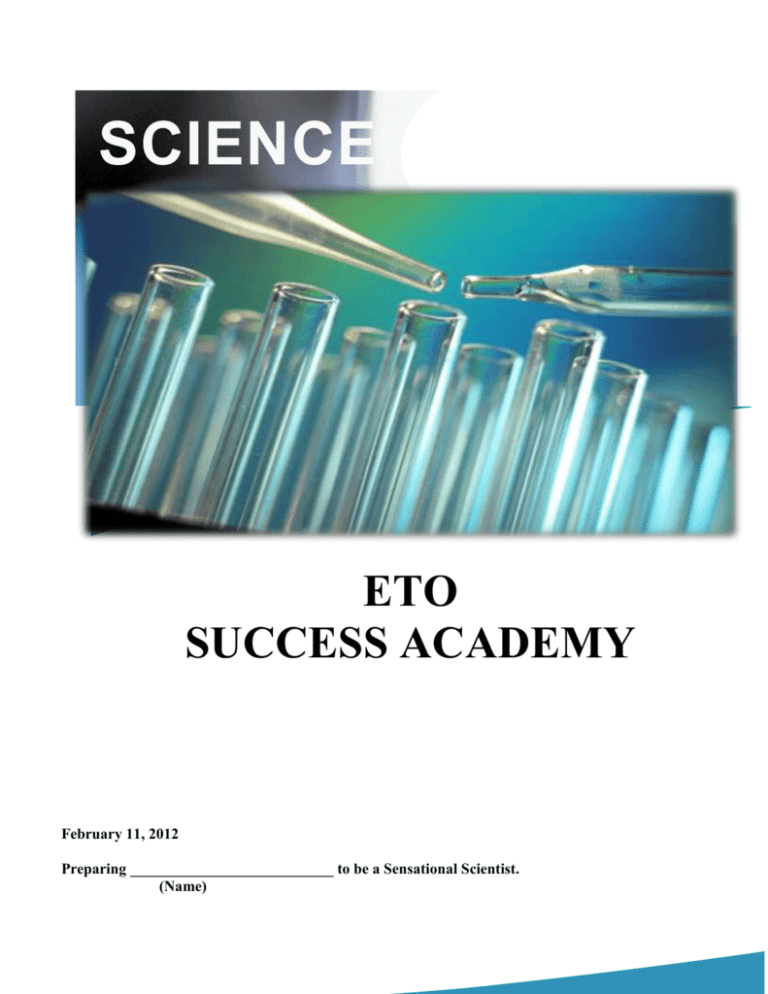
SCIENCE ETO SUCCESS ACADEMY February 11, 2012 Preparing ___________________________ to be a Sensational Scientist. (Name) Big Idea 17: Interdependence Benchmark: SC.7.L.17.2: Compare and contrast the relationships among organisms such as mutualism, predation, parasitism, competition, and commensalism. ____ Pre-assessment 1 Cleaner fish feed on parasites in a shark's mouth and gills. Which of the following best describes the relationship between the cleaner fish and the shark? A B C D competitive. mutualistic. neutral. parasitic. Explain how you decided on your answer: ___________________________________ ______________________________________________________________________ ______________________________________________________________________ ____ 2 Wildcats, such as the lynx, are predators of rabbits. Which will MOST likely occur if a new, aggressive species of wolf is introduced into the ecosystem that is a predator of the lynx? F G H J The new species population will consume the food that the rabbits eat. The population of the rabbits in the ecosystem will increase. The new species population will be consumed by the lynx. The population of the lynx in the ecosystem will increase. Explain how you decided on your answer: ___________________________________ ______________________________________________________________________ ______________________________________________________________________ 2 Student Exploration: Food Chain Vocabulary: consumer, ecosystem, equilibrium, food chain, population, predator, prey, producer Prior Knowledge Questions (Do these BEFORE using the Gizmo.) The Food Chain Gizmo™ shows a food chain with hawks, snakes, rabbits, and grass. In this simulation, the hawks eat snakes, the snakes eat rabbits, and the rabbits eat grass. 1. Producers are organisms that do not need to eat other organisms to obtain energy. a. Which organism is a producer in this food chain? ____________________________ b. Where does the producer get its energy? __________________________________ 2. Consumers must eat other organisms for energy. Which organisms are consumers in this food chain? _______________________________________________________________ Gizmo Warm-up The SIMULATION pane of the Gizmo shows the current population, or number, of each organism in the food chain. 1. What are the current populations of each organism? Hawks: _____ Snakes: _____ Rabbits: _____ Grass: _____ 2. Select the BAR CHART tab, and click Play ( ). What do you notice about each population as time goes by? _________________________________________________________________________ If populations don’t change very much over time, the ecosystem is in equilibrium. 3. Compare the equilibrium populations of the four organisms. Why do you think populations decrease at higher levels of the food chain? ______________________________________ _________________________________________________________________________ _________________________________________________________________________ 3 Activity A: Get the Gizmo ready: Click Reset ( ). Check that the BAR CHART tab is selected. Predator-prey relationships Question: Predators are animals that hunt other animals, called prey. How do predator and prey populations affect one another? 1. Observe: Run the Gizmo with several different starting conditions. You can use the + or – buttons to add or remove organisms, or you can choose Diseased from the dropdown lists. 2. Form hypothesis: How do you think predator and prey populations affect one another? _________________________________________________________________________ _________________________________________________________________________ 3. Predict: Based on your hypothesis, predict how changing the rabbit population will affect the other organisms at first. Write “Increase” or “Decrease” next to each “Prediction” in the table. Change Grass Snakes Hawks Doubling rabbit population Prediction: Prediction: Prediction: Result: Result: Result: Halving rabbit population Prediction: Prediction: Prediction: Result: Result: Result: 4. Test: Add rabbits until the population is about twice as large as it was (200% of balance). Click Play, and then Pause ( ) after approximately ONE month. Next to each “Result” line in the table, write “Increase” or “Decrease.” Click Reset and then halve the rabbit population (50% of balance). Record the results for this experiment in the table as well. A. How did doubling the rabbit population affect the grass, snakes, and hawks at first? ___________________________________________________________________ ___________________________________________________________________ B. How did halving the rabbit population affect the grass, snakes, and hawks at first? ___________________________________________________________________ ___________________________________________________________________ 4 5. Predict: Predict how changing the snake and hawk populations will affect the other organisms within the first month. In the tables below, write your predictions. Change Grass Rabbits Hawks Doubling snake population Prediction: Prediction: Prediction: Result: Result: Result: Halving snake population Prediction: Prediction: Prediction: Result: Result: Result: Change Grass Rabbits Snakes Doubling hawk population Prediction: Prediction: Prediction: Result: Result: Result: Halving hawk population Prediction: Prediction: Prediction: Result: Result: Result: 6. Test: Click Reset. Try each experiment with the Gizmo. Record each result after one month. A. How did increasing the snakes affect the grass? ____________________________ Explain why: ________________________________________________________ ___________________________________________________________________ B. How did increasing the hawks affect the rabbits? ____________________________ Explain why: ________________________________________________________ ___________________________________________________________________ 7. Draw conclusions: In general, what effect did removing prey have on predators? _________ _________________________________________________________________________ What effect did removing predators have on prey? _________________________________ _________________________________________________________________________ Extend your thinking: In North America, many top predators, such as wolves, have been driven nearly to extinction. What effect do you think this has on their main prey, deer? Write your answer on a separate sheet, and/or discuss with your classmates and teacher. 5 Predator and Prey Overview: Within every ecological community there lives a variety of species. In stable communities each of these species tends to maintain a relatively constant population size, particularly when examined over the long term. This condition is known as equilibrium. However, during times when environmental conditions change, a new equilibrium must be established. The student simulates the interactions between a predator population of lynx and a prey population of rabbits in a meadow. After collecting the data, the student graphs the data and then extends the graph to predict the populations for several more generations. The overall goals of this activity are as follows: Students will observe how population size can vary from generation to generation as a consequence of the predation relationship. Students will determine how populations of a predator species affect populations of prey species and vice versa. Students will prepare graphs comparing population size and generation for both predator and prey populations. Materials: One 7.5 cm square representing the lynx Two hundred 2.5 cm construction paper squares representing the rabbits A 30 cm x 30 cm square section of tabletop representing the meadow Graph paper Procedure: Part A: Set-Up 1. Using rulers to mark off a ‘meadow’ of 30 cm X 30 cm. Part B: Rules of Play General Rules: 1. Each surviving rabbit reproduces. 2. A lynx must capture 3 rabbits to survive. 3. Each surviving lynx reproduces. 4. No more than 200 rabbits can inhabit the meadow at any given time 5. If no lynx survives, one will immigrate into the meadow (i.e., the game doesn’t just end). 6. If no rabbits survive, 3 will immigrate into the meadow. 7. The rabbits should be distributed in the field. 8. Lynx are not allowed to cheat, but they should try to be efficient. Stupid lynx result in an overabundance of rabbits. 9. As the number of lynx increases throw the lynx square once for each lynx. You don’t have to make more lynx cards. 10. A lynx card touching any part of a rabbit card allows the lynx to catch the rabbit. 11. A lynx card landing on the meadow border counts as a turn. 6 Specific Rules: 1. Distribute 3 rabbits in the meadow. 2. Toss the lynx square once in an effort to catch a rabbit. (At this point in the activity, there is no way that the lynx can catch the 3 rabbits that it needs to survive and reproduce.) 3. Complete the data table for generation #1. 4. The lynx will starve and there will be no surviving lynx or new baby lynx. 5. At the beginning of generation #2, double the rabbits left at the end of generation #1. 6. A new lynx immigrates into the meadow. Be sure to disperse the rabbits in the meadow. 7. Continue to complete the data table for each generation that the lynx dies and that rabbits continue to double their population until eventually the rabbit population increases to a level that allows the lynx to catch 3 rabbits in a single toss. 8. Remember that the number of rabbits at the beginning of each generation is the number of rabbits not caught + the number of new baby rabbits. 9. Remember that the number of lynx at the beginning of each generation is the number of surviving lynx + the number of new baby lynx. 10. If the lynx catches 3 rabbits, it not only survives but it reproduces too! It has one baby lynx for each 3 rabbits that it catches. Therefore, if it catches 6 rabbits it will have 2 babies. 11. *Record the number of rabbits caught by each lynx. 12. The simulation is more realistic if the number of new baby lynx is based on each lynx’s catch rather than merely the total number of rabbits caught in a generation. 13. Remember that the number of rabbits in the meadow needs to be correct at all times. Remove the rabbits caught and add new ones as indicated by your data table. 14. Model about 10 generations. 15. Graph the data for 10 generations. Place both the rabbit and the lynx data (the first two columns of the data table) on the same graph so that the interrelationship can be easily observed. Label the vertical axis "Number of Animals" and the horizontal axis "Generations." Use one kind or color of line for rabbits and another for lynx. 16. Predict 4 more or up to a total of 14 generations. Base the prediction on the pattern observed during the first 10 generations. Use dotted or dashed line to illustrate your prediction on your graph paper. 7 Data Table 1: Experimental Results Generation #Rabbits 1 3 (Rabbits left x 2) #Lynx #Rabbits Caught #Lynx Surviving #New Lynx Baby Rabbits Left 1 2 3 4 5 6 7 8 9 10 Predictions: 11 12 13 14 Assessment: 1. Why was the rabbit population limited to 200 rabbits? 2. Why is it appropriate to expect the rabbits to be distributed throughout the meadow? 3. Why is it appropriate to expect rabbits and or lynx to immigrate? 4. Describe how you made your prediction of generations 11-14 in step #14 of the specific procedure. 5. Describe what would happen to the rabbit population if after generation #10, hunters set out traps to trap and kill all the lynx. 6. Describe what would happen to the rabbit and lynx population if after generation #10, there was a severe drought that killed all the grass and vegetation. 8 9 ASSESSMENT NAME: _________________________ ____ 1 Some animals in the northern latitudes have to migrate south in order to survive. What abiotic factor causes the animals to annually leave their ecosystems? F G H J ____ ____ decreasing the potential for soil erosion. increasing the food available for consumers. decreasing the nutrients available for new plants. increasing the accumulation of organic materials. 3 Scientists have discovered that there has been a reduction in the butterfly population in an ecosystem. After much research, they have identified that the carrying capacity for butterflies has been decreased. If the scientists want to increase the butterfly population, which action should they recommend? F removing primary producers G spraying of insecticides H increasing runoff J planting flowers 4 In 1989, an oil spill off the coast of Alaska led to a decline in the population of many organisms. Which other population was MOST likely affected by the drop in population of the fish, otters, and seals? A B C D ____ heavy rains less oxygen cold weather increased sunlight 2 The removal of plant material, such as grass clippings, would MOST likely affect an ecosystem by A B C D ____ DATE: ______________ Deer Eagles Frogs Snakes 5 In the geologic past, abiotic factors such as volcanic eruptions have had an impact on the availability of resources. How can volcanic eruptions impact the availability of resources? F G H J carbon dioxide minerals sunlight water 10 ____ 6 In any ecosystem, the survival of a species depends on the resources that are available. Beneath the tree canopy in a tropical rainforest, growth of some plant species may be limited. The availability of which of these resources most likely limits the growth of plants on the ground level in this ecosystem? A B C D ____ 7 In a grassland ecosystem, organisms of the same species eat the same food. When there is a lack of rain, which is MOST likely increased? A B C D ____ carrying capacity population density competition for space competition for resources 8 Wolves, which are top predators, were eliminated from Yellowstone National Park in the 1930s. In 1995, wolves were reintroduced into Yellowstone. During the period in which wolves were absent from Yellowstone, which MOST likely occurred? F G H J ____ Less solar radiation would enter the region. Larger plants and trees would take over the region. The region would become a habitat for large and small sea organisms. The primary producers in the region would have less ability to recycle carbon. an increase in competition for food resources among small prey a greater opportunity for primary producers to flourish an increase in the population of tertiary consumers a greater balance of predator-prey relationships 9 Which of the following is an example of parasitism? A. B. C. D. bees and flowers a tick on a dog barnacles attached to a whale a wolf and a rabbit 11


